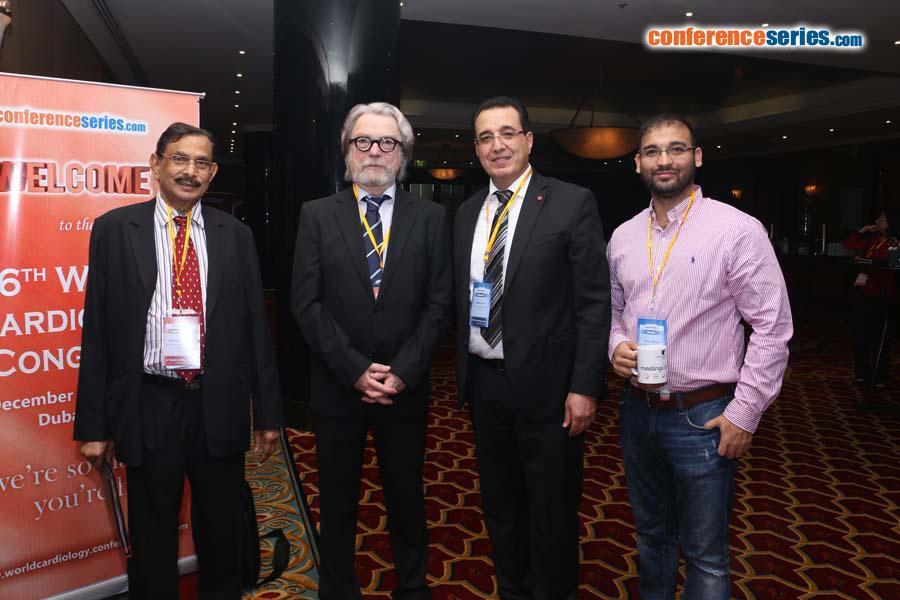
Orhan Zengin
Gaziantep University,Turkey
Title: Ventricular repolarization disturbances in high dose intravenous methylprednisolone therapy
Biography
Biography: Orhan Zengin
Abstract
Backgrounds: Prolongation of the peak and the end of T wave (Tp-e) has been reported to be associated with ventricular arrhythmias. High dose pulse intravenous steroids (pulse therapy) are an accepted practice to treat severe manifestations of inflammatory, autoimmune and renal diseases. Sudden death, cardiac arrhythmias, circulatory collapse and cardiac arrest have been reported occasionally, usually following rapid administration of large doses of methylprednisolone.
Methods: We enrolled 50 consecutive various inflammatory and autoimmune diseases in patients with acute relapse to perform ECG 4 hours before, and 12 hours after infusion of 1000 mg intravenous (IV) methylprednisolone. Myocardial repolarization can be evaluated with QT interval (QT), corrected QT interval (QTc), QT dispersion, and transmural dispersion of repolarization. (Tp-e), which is the interval between the peak and the end of T wave on electrocardiogram (ECG), is accepted as an index of transmural dispersion of ventricular repolarization. JT dispersion (JTd), corrected JT (JTc), (Tp-e)/QT ratio, (Tp-e)/QTc ratio are also used as an electrocardiographic index of ventricular arrhythmogenesis. Our goal in these patients, we aimed to assess ventricular repolarization in patients with before and after high dose pulse intravenous steroids therapy in patients.
Results: The baseline characteristics of the patients before and after high dose pulse intravenous steroids therapy are presented in the table 1 and 2.
Conclusions: Our results show that after high dose pulse intravenous steroids therapy in patients is associated with prolonged Tp-e interval and increased Tp-e/QT and Tp-e/QTc ratio.
Table 1: Characteristics of the Study Population
|
|
(n=50) |
|
Sex(Female/Male) |
36/14 |
|
Age(years) |
36±13 |
|
BMI(kg/m2) |
25,77±3,57 |
Table 2: Electrocardiographic Measurements of the Patients
|
|
Before(n=50) |
After(-)(n=50) |
P(value) |
|
RR(msn) |
713,20±159,82 |
840,60±191,30 |
0,001 |
|
Heart Rate(beat/min) |
87,16±17,45 |
73,86±17,45 |
0,001 |
|
PR(msn) |
143,90±21,51 |
132,90±15,58 |
0.004 |
|
QRS(msn) |
88,74±13,61 |
88,86±12,07 |
0,963 |
|
P wave dispersion (msn) |
16,20±6,96 |
16,60±8,71 |
0,800 |
|
T wave (msn) |
170±29,13 |
181,20±23,26 |
0,03 |
|
(Tp-e) (msn) |
74,60±13,12 |
83,80±13,68 |
0,001 |
|
QT(msn) |
361,0±29,91 |
388,20±42,84 |
0,001 |
|
QTd(msn) |
18,80±10,62 |
17,60±7,70 |
0,520 |
|
QTI(%) |
114,59±12,48 |
108,06±18,84 |
0,04 |
|
QTc(msn) |
401,60±19,79 |
413,72±26,38 |
0,01 |
|
JT(msn) |
273,0±28,73 |
299,60±45,66 |
0,001 |
|
JTd(msn) |
20,20±9,36 |
22,80±9,26 |
0,166 |
|
JTc(msn) |
325,98±27,74 |
329,38±30,78 |
0,563 |
|
JTI(%) |
118,18±17,54 |
110,56±13,92 |
0,01 |
|
(Tp-e)/QT(msn) |
0,20±0,03 |
0,21±0,03 |
0,112 |
|
(Tp-e)/QTc(msn) |
0,18±0,03 |
0,20±0,03 |
0,009 |
QTd: QT interval dispersion, QTI: QT interval index, QTc: Corrected QT interval, JTd: JT interval dispersion, JTc: Corrected JT, Values are presented as mean±SD.p<0.05.




